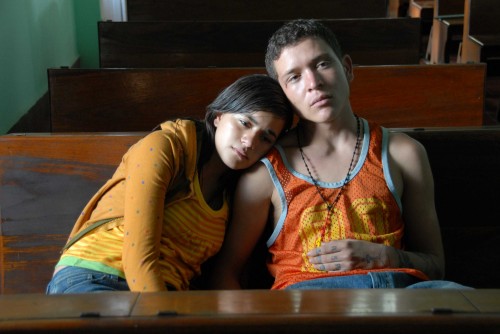Sin Nombre
Front Row Seats for Love and Crime

Starring: Edgar Flores, Paulina Gaitan
By Tom Bevis
There is a mural painted on the wall. Green grass, red and yellow leaves, and if you look closely, you might see a sliver or blue sky beyond the tangled branches of trees lining a sedate path through the tranquil walkway. Then the camera shifts. The image of the walkway, in all the flames and serenity of autumn, shifts and what we’re left with is the starving urban backdrop of the film. What you’re about to see, from this point on, is an honest and unabashed view of love and crime on the way to the United States.
Sin Nombre tells the story of two central characters. The first is Sayra (Gaitan), a girl who is reunited with her father in a journey from Mexico to the United States. The second is that of Willy (Flores), a gang member on the run from his former brothers in crime. The main focal point of the film is watching how these two arcs interact and influence one another.
For those of you who read my Gomorra review, you know my view on foreign film. For those of you not in the know, I can only tell you that by and large, I don’t understand the pacing and tone used by several foreign film markets. While this film doesn’t move with the speed as most American films, I can say that it stands among some of the best foreign films that have seen America’s golden shores.
The characters are given the room they need to grow and expand, emotionally, psychologically, and physically – as much of the story is told in transit. Director Cary Fukunaga takes full advantage of every pause, every scene, every jump, every span of time and uses it to develop and mold character. There is no wasted time on screen, and this is what makes great pacing in a film.
So, by the end of the film, the two pivotal characters are fully textures, transformed, and realized. The actors chosen – in these roles and in lesser roles – carry themselves perfectly, playing each character not only adequately but entirely effectively. I’ve heard some commotion about character accents and Central American dialects, but one has to understand that the film industry in Central America is fledgling at best, and the fact that the actors understood the differences in regional accents and clearly attempted to adapt to them is more than commendable.
The cinematography is basic, an indicator of the loose and upcoming Central American film industry, but it is more effective than slick camera work on glossy and clear stock would have been (and digital is just out of the question). The rough grain of the film and the quick camera motions and sudden yet subtle editing become not only our conveyance into the story, but also characteristic of the story unfolding. It’s not a pretty tale we’re hearing, so neat and even camerawork would be unfitting and would be disastrous to the tone the director and filmmakers worked so hard to establish.
What really gives the movie all of its power is its bold audacity. The film truly pulls no punches; neither of the arcs result in the typical big Hollywood endings you would expect. The story is one of the strongest and most sincere I’ve seen in a long time. It shows the duality of crime in poverty ridden territories; the ugly, brutal side that yields murder, theft, and rape, but also the necessary side, the promise of brotherly union, a bond that can’t be fulfilled elsewhere – a promise to belong. At the same time, it tells of the honest struggle of the very same poverty-stricken people as they venture for a better life and all the hardships found on that long road.
All-in-all, Sin Nombre is a beautifully choreographed and orchestrated waltz with violence and romance that resonates with the audience. If it weren’t for the film’s tight budget and small release, it could easy grow and succeed in the mainstream, but it’s a shame we won’t see that happen. Sin Nombre is everything Gomorra should have been and then some.
4.5/5
